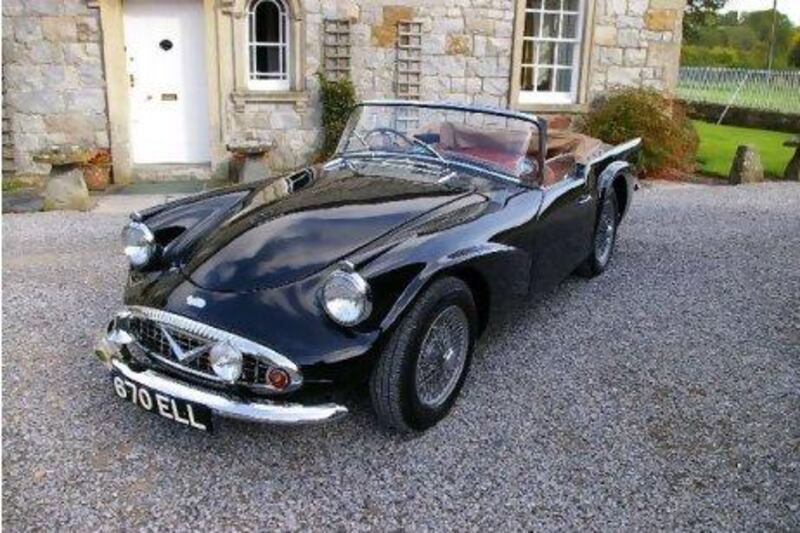In the 1960s heyday of British sports cars, one model stood out from the crowd. While Jaguar's E-Type was the most iconic, its stablemate, the Daimler Dart, was certainly the most idiosyncratic. It was the renegade model from the marque that embodied the Establishment.
Not to be confused with German firm Daimler AG, Daimler was one of the oldest, most revered car manufacturers in Britain, specialising in coach-built limousines that were as exquisite as they were expensive. But by the mid-1950s the firm was in financial trouble and looking to expand its horizons. After all, though being the official car supplier to the British royal family is a proud accomplishment, it also limits the customer base to those that own castles.
Sports cars were in vogue in the swinging Sixties, with no rock star worth his salt driving a car with a hardtop, so Daimler tried its hand. The result was always going to be experimental.
Even today the Dart retains its head-turning looks that are somewhere in the spectrum between beautiful and barmy. A football commentator would describe it as a car of two halves: from the rear it has aggressive, American lines with accentuated fins while the sloping bonnet, oval grille and goggle-eye headlights of the front profile give it the appearance of a salmon, rather than a sports car. But though it lacks the classical lines of an Austin Healey or E-Type, it has a road presence all its own.
Its awkward yet alluring looks are not the only aspect of the Dart that challenged conventional sports car wisdom. Back then British marques favoured a silken straight six. The V8 was an American engine configuration, where grunt had a greater value than grace. But the Dart bucked this trend with an all-new, compact 2.5L V8, one of the smallest eight-cylinder engines ever made. This innovative engine was housed within one of the first fibreglass bodies in a mainstream model. Sports car purists must have scratched their heads and turned up their noses when the Dart was unveiled at the 1959 New York motor show. But Daimler was new to the market and brought with it a new vision of a sports car.
The Dart, officially sold as the SP250 (Dodge had claimed the name for its own sports car prototype), was developed to exploit the increasingly lucrative American market. This accounts for the choice of a V8 and for the bold styling, which was perhaps too brash for English sensibilities. But in a five-year production run only 2,645 were made, a mere 10 per cent of projected sales. It was to be the first and last Daimler sports car before the brand went back to what it built best - limousines with a long wheelbase.
The failure of the Dart, at least in commercial terms, was partly due to the car itself and partly down to circumstance. From the outset, its reputation was dogged by poor reliability and question marks over build quality. This was not expected from a marque that took HRH Elizabeth Regina on hand-waving tours of her subjects. Her Majesty would also have been perturbed by the Dart's unfortunate habit of opening its doors while cornering at speed, a fault in the rigidity of a primitive chassis struggling to harness its 140hp.
But despite these flaws the Dart may have enjoyed greater success had it been better promoted. In 1960, a year after production began, Daimler was acquired by Jaguar which, a year later, would unveil one of the most celebrated sports cars ever made. Unsurprisingly, the Dart suffered in comparison and wasn't given the advertising it needed to succeed in a very competitive market. Jaguar had the race track pedigree and Daimler the royal prestige. That was the way of the world, and the Dart was the exception that proved the rule.
Considered something of an errant son by its feline foster parent, the Dart failed to realise its potential or capture the public imagination like other cars of the period. But its calibre as a sports car stands up to scrutiny. It was capable of topping 193kph and achieving 0-100kph in 8.9 seconds. This made it far faster than competitors such as the Austin Healey or MGA. In fact, it was so sprightly that the British police bought a fleet as high-speed pursuit cars. It was the dream of every bobby on the beat to get behind the wheel - after all, how often do police officers get to drive a high-speed convertible?
The Dart may just be a footnote in motoring history but, considered on its own merits, it had a lot to offer. Few cars combine sumptuous luxury, serious speed and unique styling. That is why this mere footnote will set you back just as much as an E-Type, about which a whole chapter was composed.






